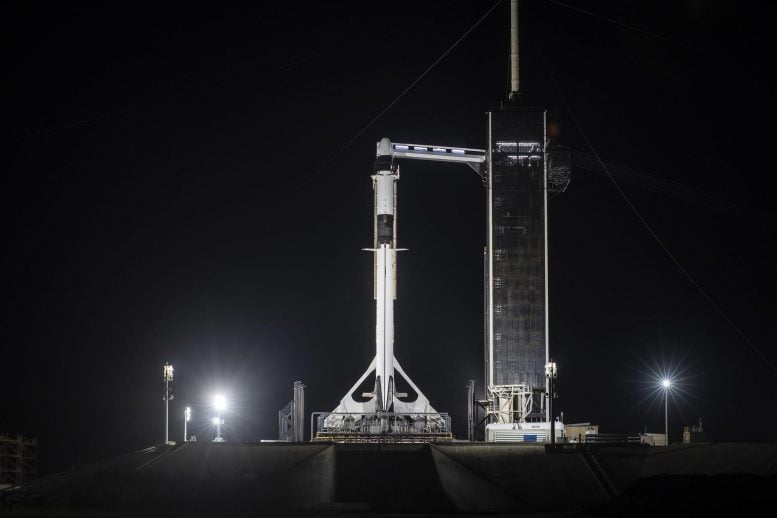
The SpaceX Falcon 9 rocket with the Dragon capsule atop is raised to the vertical position on June 2, 2021, at Launch Complex 39A at NASA’s Kennedy Space Center in Florida, in preparation for the company’s 22nd Commercial Resupply Services mission for NASA to the International Space Station. NASA and SpaceX are targeting Saturday, August 28, at 3:37 a.m. EDT, for launch of the 23rd commercial resupply services mission. Credit: SpaceX
The 23rd SpaceX cargo resupply services mission carrying scientific research and technology demonstrations to the International Space Station is targeted to launch in late August from NASA’s Kennedy Space Center in Florida. Experiments aboard include an investigation into protecting bone health with botanical byproducts, testing a way to monitor crew eye health, demonstrating improved dexterity of robots, exposing construction materials to the harsh environment of space, mitigating stress in plants, and more.
Highlights of the payloads on this resupply mission include:
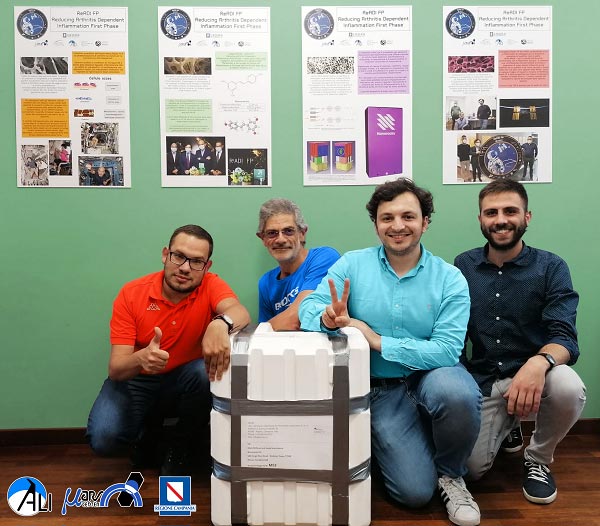
Shown with their experiment packed for launch, READI FP team members from left to right, Michele Cioffi, program manager; Fabio Peluso, honorary member of MARSCenter scientific committee; Marco Fabio Miceli, system and test engineer; and Pasquale Pellegrino, test engineer from Aerospace Laboratory for Innovative components (ALI) S.C. a r.l. in Italy. Credit: ALI scarl/Marcenter
Building bone with byproducts
READI FP evaluates the effects of microgravity and space radiation on growth of bone tissue and tests whether bioactive metabolites, substances such as antioxidants formed when food is broken down, might protect bones during spaceflight. The metabolites tested come from vegetal extracts generated as waste products in wine production.
Protecting the health of crew members from the effects of microgravity is crucial for the success of future long-duration space missions. This study could improve understanding of the physical changes that cause bone loss and identify potential countermeasures. This insight also could contribute to prevention and treatment of bone loss on Earth, particularly in post-menopausal women. Sourcing metabolites from materials that otherwise would become waste is an additional benefit.
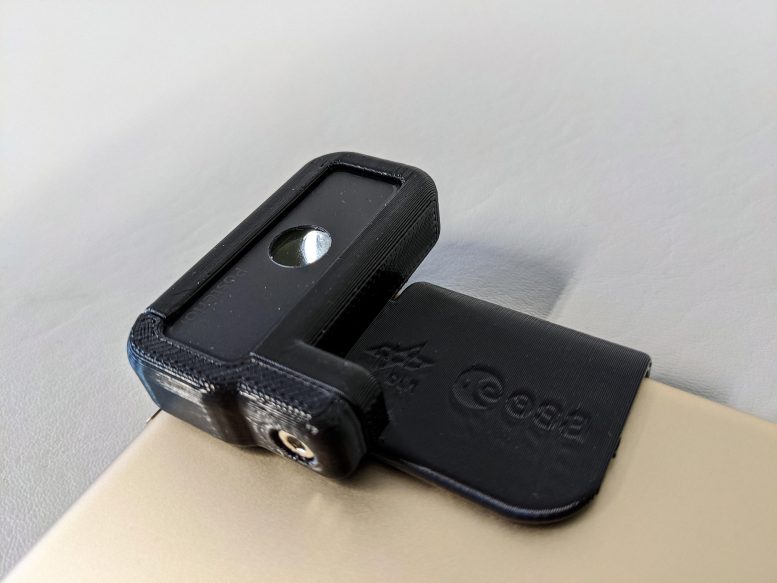
Preflight view of the hardware for Retinal Diagnostics, an investigation testing a commercially available ophthalmology lens to capture images of the human retina in space. Credit: DLR/EAC
Keeping an eye on eyes
Retinal Diagnostics tests whether a small, light-based device can capture images of the retinas of astronauts to document progression of vision problems known as Space-Associated Neuro-Ocular Syndrome (SANS). The device uses a commercially available lens approved for routine clinical use and is lightweight, mobile, and noninvasive. Videos and images can be downlinked to test and train models for detecting common signs of SANS in astronauts. The investigation is sponsored by ESA (European Space Agency) with the German Aerospace Center (DLR) Institute of Space Medicine and European Astronaut Centre (EAC).
“SANS is present in over two-thirds of astronauts and thought to be associated with long duration (30 days or longer) exposure to microgravity,” said principal investigator Juergen Drescher of DLR. “Currently, visual problems that may manifest from SANS are mitigated by providing glasses or contact lenses to crew members. Multi-year missions to Mars may worsen these symptoms, and there is a need for a mobile device for retinal image diagnostics. While developed for space, this mobile technology has potential to provide diagnostics in remote and extreme environments on Earth at reduced cost. Mobile biomedical diagnostic devices such as these will likely emerge as both an enabler of human deep space exploration and a sustainable model for health care on Earth.”
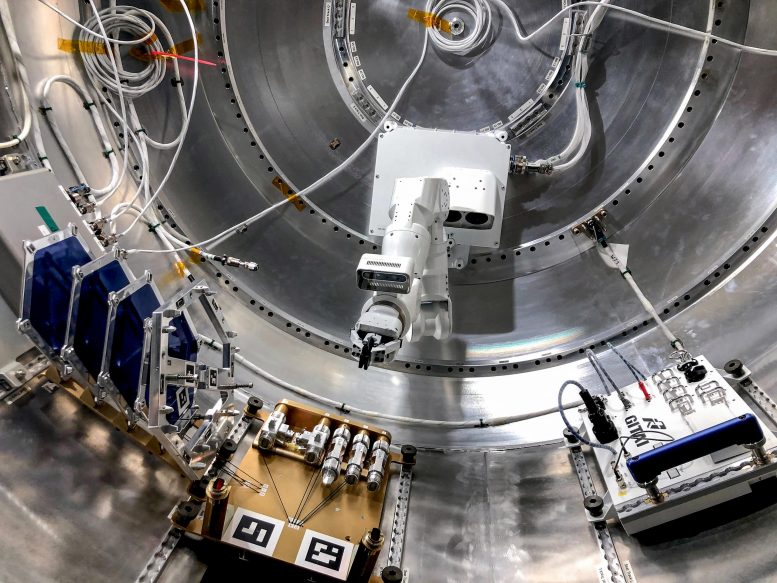
This image shows the complete configuration of the GITAI S1 robotic arm inside the Bishop mock-up. Credit: GITAI, NRAL
Robotic helpers
Nanoracks-GITAI Robotic Arm demonstrates the versatility and dexterity in microgravity of a robot designed by GITAI Japan Inc. Results could support development of robotic labor to support crew activities and tasks, as well as servicing, assembly, and manufacturing tasks while in orbit. Robotic support could lower costs and improve crew safety by having robots take on tasks that could expose crew members to hazards. The technology also has applications in extreme and potentially dangerous environments on Earth, including disaster relief, deep-sea excavation, and servicing nuclear power plants. The experiment will be conducted under the pressurized environment inside the Bishop Airlock, the space station’s first commercial airlock.
“This technology demonstration is to show the world that the capabilities necessary for automation in space are finally available,” said company chief technology officer Toyotaka Kozuki. “It provides an inexpensive and safer source of labor in space, opening the door to the true commercialization of space.”
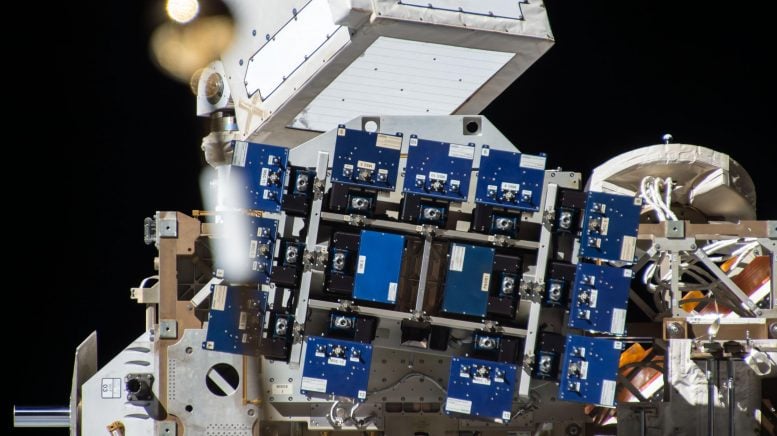
Photo documentation of the Materials ISS Experiment Flight Facility (MISSE-FF) platform aboard the International Space Station. Credit: NASA
Putting materials to the test
MISSE-15 NASA is one of a series of MISSE investigations testing how the space environment affects the performance and durability of specific materials and components. These tests provide insights that support development of better materials for future spacecraft, spacesuits, planetary structures, and other components needed for space exploration. Testing materials in space has the potential to significantly speed up their development. Materials capable of standing up to space also have potential applications in harsh environments on Earth and for improved radiation protection, better solar cells, and more durable concrete. Alpha Space provides the MISSE-FF lab that hosts these investigations.
“MISSE-15 includes tests of concrete, spacecraft materials, fiberglass composites, thin-film solar cells, radiation protection materials, a micro-optical chip, 3D printed polymers, and more,” said MISSE project engineer Ian Karcher. “In addition, the availability of this platform for commercial technology development contributes to the ongoing commercialization of space and development of new space technologies.”
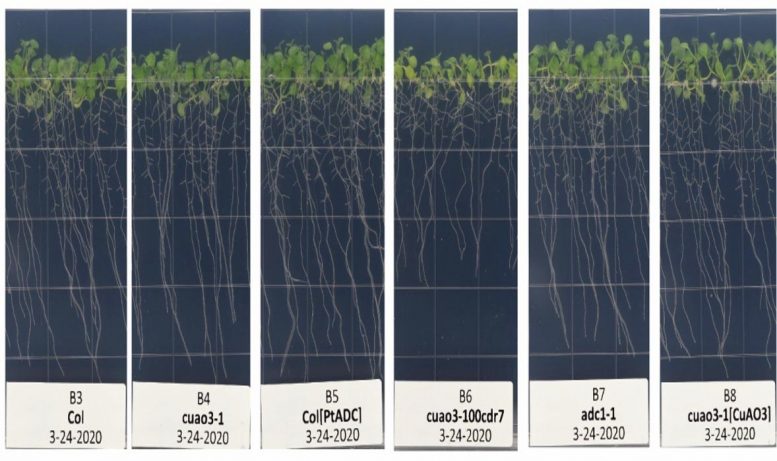
Image of seedlings with different genotypes following 9 days of growth in the VEGGIE chamber under temperature, humidity, and carbon dioxide conditions mimicking those recorded on the space station. Taken during verification testing at NASA Kennedy Space Center. Credit: Dr. Shih-Heng Su
Helping plants deal with stress
Plants grown under microgravity conditions typically display evidence of stress. APEX-08 examines the role of compounds known as polyamines in the response of thale cress to microgravity stress. Because expression of the genes involved in polyamine metabolism remain the same in space as on the ground, plants do not appear to use polyamines to respond to stress in microgravity. APEX-08 attempts to engineer a way for them to do so. Results could help identify key targets for genetic engineering of plants more suited to microgravity.
“On Earth, polyamines have been shown to contribute significantly to the mitigation of multiple environmental stresses in plants,” said principal investigator Patrick Masson, a professor at University of Wisconsin-Madison. “Altering the metabolism of a polyamine to mitigate the stress of microgravity could have an impact on our ability to use plants as key components of bioregenerative life support systems on long-term space exploration missions. It also may improve our understanding of the molecular mechanisms that allow plants to respond to general environmental stress on Earth, with impacts on agriculture, horticulture, and forestry.”
Easier drug delivery, Girl Scouts send science to space
The Faraday Research Facility is a multipurpose research facility that uses the space station’s EXPRESS racks. On this first flight, the facility hosts a Houston Methodist Research Institute experiment and two STEM collaborations, including “Making Space for Girls” with the Girl Scouts of Citrus Council.
“The ProXopS Faraday Research Facility, developed in partnership with L2 Solutions Inc., is designed to operate remotely and provide a controlled environment for power, command and control, telemetry responses, and safety assurance for microgravity experiments,” said Chad Brinkley, president of ProXopS LLC and L2 Solution Inc. “An added benefit with the facility is that experiments return to the ground for evaluation.”
Faraday-NICE tests an implantable, remote-controlled drug delivery system using sealed containers of saline solution as surrogate test subjects. The device could provide an alternative to bulky, cumbersome infusion pumps, a possible game changer for long-term management of chronic conditions on Earth. Potential problems with such pumps include high infection risk, electromechanical failures, and double dosing. NICE is minimally invasive, implantable, has no moving mechanical components, and does not require catheters. Remote-controlled drug delivery could increase patient compliance, especially for children, elderly, and disabled individuals.
Faraday-Girl Scouts places control experiments with a Girl Scout troop and provides students with images of the same experiments in space. The studies include plant growth, ant colonization, and the brine shrimp lifecycle.
Article From & Read More ( Intriguing Science Experiments Launching on SpaceX’s Cargo Resupply Mission to the Space Station - SciTechDaily )https://ift.tt/3iWPk4U
Science
No comments:
Post a Comment